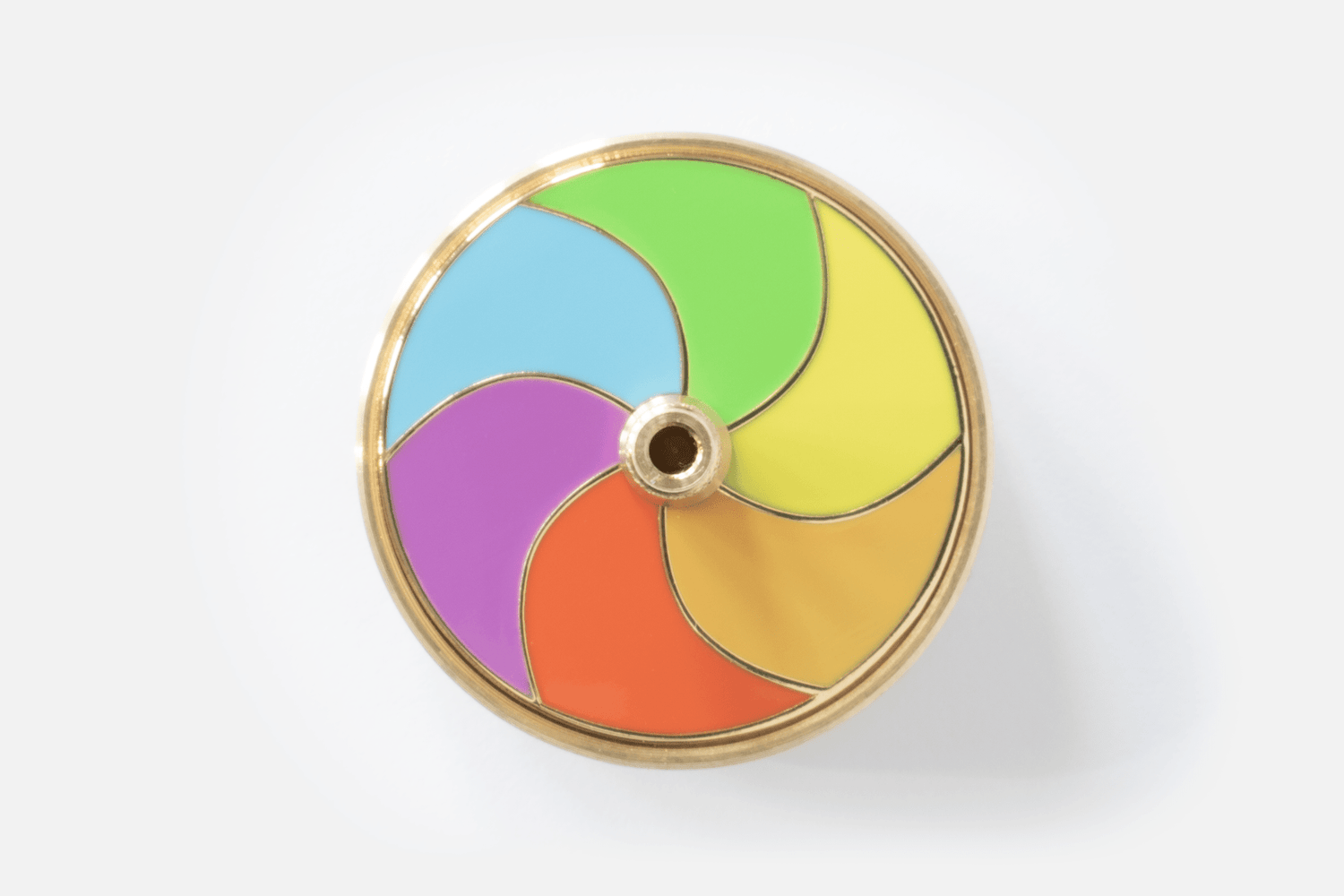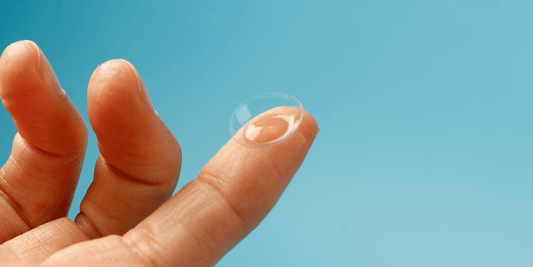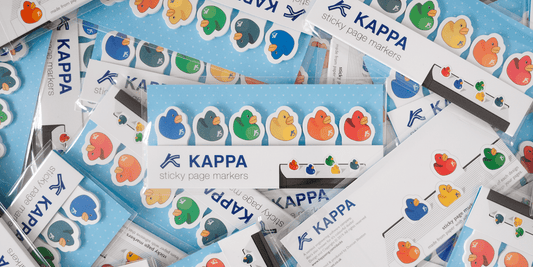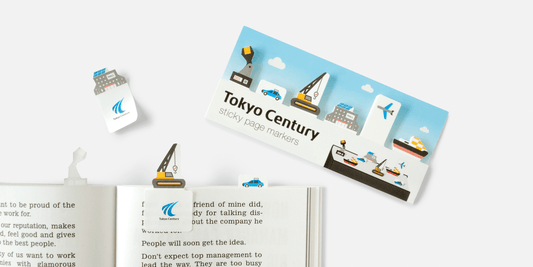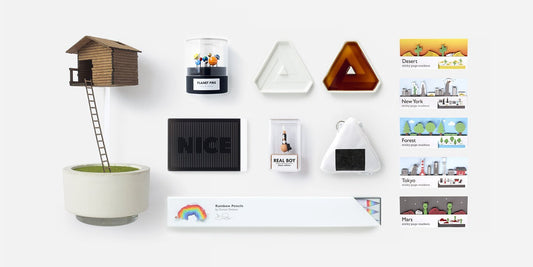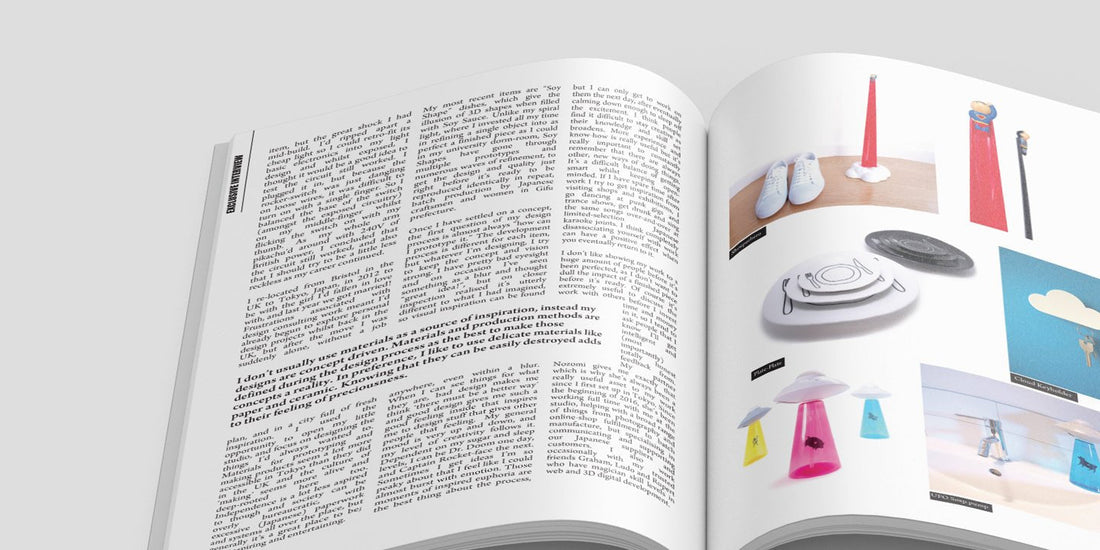
HUF magazine exclusive interview
Where do you live and work, Japan? What’s it like living and working there? How does it differ to your time in the UK? What made you choose Japan?
I re-located from Bristol, UK to Tokyo, Japan in 2012 to be with the girl I’d fallen in love with, and last week we got married! ^^
Frustrations associated with design consulting work meant I’d already begun to explore personal design projects whilst back in the UK, but after the move I was suddenly alone, without a job plan, and in a city full of fresh inspiration. I used the opportunity to open my little studio, and focus on designing the things I’d always wanted to. Materials for prototyping and making products seem a lot more accessible in Tokyo than they did in the UK and the culture of ‘making’ seems more alive and deep-rooted here too. Independence is a lot less aspired to though and society can be overly bureaucratic, with excessive (Japanese) paperwork and systems all over the place, but generally it’s a great place to be; safe, inspiring and entertaining.
How do you describe yourself as an artist? Or designer?
When people ask, I tell people I’m a designer, but my approach is a lot more about exploring and expressing creativity rather than solving a specific need or ‘gap in the market’, so in that sense, perhaps I’m more of an artist.
Can you tell us about your designing? (How and where did you start? What does it entail? What’s it like? Is it fun?)
The aim of my work is to subtly embed moments of happiness into everyday things. I use themes like play, wit and illusion to create a range of original products and limited edition items that converge simple ideas with serious product design.
What was the first item you designed and made? What was your most recent and how did it differ from your very first?
The first almost-real-product-like thing I designed was at Uni; the “spiral” light for conceptual brand “mi-light” (which stood for m-echanical i-nteraction light). The thing I remember most about that project was not the finished item, but the great shock I had mid-build. I’d ripped apart a cheap light so I could retro-fit it’s basic electronics into my light design and whilst exposed, I thought it would be a good idea to test the circuit still worked. I plugged it in, but because the rocker-switch was just dangling on loose wires, it was difficult to turn on with a single finger. So I balanced the base of the switch (amongst the exposed circuitry) on my middle-finger whilst flicking the switch on with my thumb. As my whole arm pikachu’d around with 240W of British power, I concluded that the circuit still worked, and also that I should try to be a little less reckless as my career continued.
My most recent items are “Soy Shape” dishes, which give the illusion of 3D shapes when filled with Soy Sauce. Unlike my spiral light, where I invested all my time in refining a single object into as perfect a finished piece as I could in my university dorm-room, Soy Shapes have gone through multiple prototypes and numerous waves of refinement, to get the design and quality just right before it’s ready to be reproduced identically in repeat, batch production by Japanese craftsmen and women in Gifu prefecture.
Did you study design academically?
At the end of basic schooling, my art teacher suggested I go to the local college to study Art & Design foundation for a year. It was so awesome. Immersed amongst many inspiring peers, I was able to explore and experiment in many creative disciplines from life drawing to textiles in the first 6 months, before specialising in the workshop-based “3D” team in the second. As marvellous as the freedom was, my ideas were not focused enough and I lacked the technical skills and equipment to make them properly, so as a result, the work I produced was largely horrendous. Luckily, my experienced tutors were able to look at my portfolio and advise how and where I might continue my studies. They guided me towards Brunel University in West London to study Industrial Design & Technology. I graduated in 2008 with the one-off “DigiMech Clock” that I’d conceptualised, designed, crafted, built, and programmed myself as a physical representation of my learning. It got me my first design job, and is still one of my favourite past-projects.
Studying product design was a great choice for me as a young, confused creative who liked inventing and making things as I could continue experimenting whilst learning a massively diverse range of practical skills. Following graduation, my friends have now specialised in research, engineering, licensing, illustration, branding, fabrication, film production, packaging and graphic design, as well as continuing product design in it’s wider sense.
When you are preparing to design a piece, what are you thinking about?
Once I have settled on a concept, the first question of my design process is almost always “how can I prototype it”. The development process is different for each item, but whatever I’m designing, I try to keep the concept and vision strong.
Does your creative passion ebb and flow? How do you feel when you know you’re onto something and how do you keep creativity flowing?
My general mood is very up and down, and my level of creativity follows it. Dependent on my sugar and sleep levels, I can be Dr.Doom one day, and Captain Rocket-face the next.
Sometimes I get ideas I’m so peaky about I feel like I could almost burst with emotion. Those moments of inspired euphoria are the best thing about the process, but I can only get to work on them the next day, after eventually calming down enough to sleep off the excitement.
I think people find it difficult to stay creative as their knowledge and skill set broadens. More experience and know-how is really useful but it’s really important to constantly remember that there’s always other, new ways of doing things. It’s a difficult balance of getting smart whilst keeping open minded.
Do you draw inspiration from anything or anyone to aid creativity?
I have pretty bad eyesight and on occasion I’ve seen something as a blur and thought “great idea!”, but on closer inspection realised it’s utterly different to what I had imagined, so visual inspiration can be found anywhere, even within a blur.
When I can see things for what they are, bad design makes me think ‘there must be a better way’ and good design gives me such a good feeling inside that inspires me to design stuff that gives other people that feeling.
Do you also work with a team? If so, what’s your perspective on picking/working with a team?
I don’t like showing my work to a huge amount of people before it’s been perfected, as I don’t want to dull the impact of a finished piece before it’s ready. Of course it’s extremely useful to discuss the work with others before I invest time and money in it, so I tend to ask people that I know I’ll get intelligent and (most importantly) totally honest feedback from. My partner Nozomi gives me exactly that which is why she’s always been a really useful asset to my work since I first set up in Tokyo. Since the beginning of 2016, she’s been working full time with me at the studio, helping with a broad range of things from photography to online-shop fulfilment to batch manufacture, but specialising in communicating and supporting our Japanese suppliers and customers. I also work occasionally with my trusted friends Graham, Ludo and Rupert who have magician skill levels in web and 3D digital development.
What challenges do you face as a designer?
One of the biggest challenges that faces our little studio is speed of new product output. The world moves so fast and people are constantly looking for what’s new and exciting, but it’s difficult for a small, original product design business to keep up. Although our products are mostly on the simpler end of the product design complexity scale (compared to say a car or a camera), each of them uses new materials, technologies and suppliers. In this sense, each project kind of starts from scratch, and the design process is long.
If you could change one thing about modern day design and life in general, what would you change and how?
When pitting one product against another, the majority of people factor in cost to their buying decisions. One product offers various benefits, whilst another offers enough similar benefits but at a cheaper cost, and that’s normally enough to convince someone that that’s the one to buy, after all, no one has time, or cares to take the time to evaluate every single purchase they make in much more depth. However, I sometimes think it’s a bit sad that people rarely consider where that product comes from when they buy it, and what businesses they’re supporting when they do so. So if I could change one thing about modern day culture and lifestyle, it would be to increase peoples support for small, independent businesses and makers. Of course this is another design, branding, marketing and communication job for the independent businesses themselves, but for a little business, that’s a whole lot of time and investment that has to be borrowed from another activity.
Individual work can be the subject of criticism, have you ever felt criticised and how did you deal with it?
On the rare occasion that my work receives criticism, it’s invariably about cost. It really stings to hear when it’s said in such a casual, throwaway manner, after I’ve put so much time & effort into making a standard item much more special, after investing in more elaborate manufacturing techniques and materials, paying suppliers fairly and adding only a very small profit margin on top.
I used to be upset and take those peoples comments as insults of sorts, but now I try to remind myself that those opinions are made because of a lack of understanding about the processes involved in producing products, and that it’s my (and every designers) job to communicate those processes to users.
On the whole though, people are very kind and positive about my work and I’ve managed to build a small group of awesome people across social media and especially kickstarter, which is a really good platform to share your project story and process clearly.
Outside of your work – What do you do to improve, invigorate and motivate yourself? (Continued learning,hobbies,pastimes,etc)
If I have spare time after work I try to get inspiration from visiting shops & exhibitions, I go dancing at punk gigs and trance shows, get drunk and sing the same songs over and over at limited-selection Japanese karaoke joints. I think completely disassociating yourself with work can have a positive effect when you eventually return to it.
Which is your favourite piece that you’ve designed and made so far, and why?
One of my favourite works is the first one I produced in any kind of volume; (the original) cloud keyholder. I hand-cast 150 limited edition pieces in my Mum & Dads kitchen in a ceramic-based material called Jesmonite. I then flew to Sweden for a week to exhibit them with “designboom-mart” before setting up my etsy shop where they eventually sold out. The whole process was very labour intensive and felt very personal. I later licensed the design to “Suck-UK” who mass-produced a plastic version which was able to reach a much wider market. It’s great that more people can continue to enjoy the design, but still, the limited-edition originals remain much more special to me and hopefully to the other 149 people that still own one of them. I’m more emotionally connected to a piece when I’m involved in the physical making of a it, and if I can feel close to the people who eventually own it.
Also, limited editions by their very nature have a definite end, which means they, as physical objects, are embedded with a meaningful story and become much more than just “things”.
What is your definition of success and has it changed over the years?
I used to dream about producing products that held my name, and I started doing that ever since Cloud Keyholder in 2011. Then my dreams shifted into making specific ideas a reality. Sometimes I had to put a huge amount of physical time and effort in myself, like when I hand painted 1,000 limited edition sets of two “Real Boy” push pins. In other instances, when only a specialist manufacturer could produce products like “Rainbow Pencils” and “Sticky Page Markers”, I’ve used kickstarter to generate up-front support.
Getting enough investment to make a product a reality is an obvious measure of success, but it’s the positive feedback and personal communication I get from the kickstarter community that really make me feel like my work is meaningful and worth doing.
I’ve had a long-term, seemingly simple, but yet to be achieved goal to get my own Wikipedia page. To be a worthy marker of success, it has to occur organically, which is why frustratingly, I can’t do much to make it happen…
I’d like to design more “signature work” for other brands in the future. Earlier this year McDonalds Japan commissioned me to create six ‘signature’ posts for their brand new instagram feed. The first set (of three posts) showed paper being ripped away from pre-prepared models to create visual representations of McDonalds food, with ripped edges representing the textured elements. The second set were stop-motion animations that played with the concept of the ‘drive-thru’, depicting a ‘swim-thru’, ‘fly-thru’ and ‘hover thru’. Just being asked to do that kind of job, I felt I’d reached some level of success.
Of course success is dependent on where you set the bar and on what you’re trying to achieve. Like most people, I’m constantly resetting the bar, and the feeling of success is only temporary.
How do/will you know you’ve achieved it (success)?
I have some aims like “make this product a reality” or “own my own physical shop”, which once complete, are easily measurable, and can be used as a indicator of success. However, broader goals like “make a decent living” are much less tangible because my income is never stable. Successful projects eventually slow down, profits get re-invested, and I’m in a constant race to get another project out to keep the momentum up whilst trying to balance everything else that comes attached to running a small business.
I hope to eventually reach some level of stability and be content with what I have achieved, but I’m still a long way off.
Which materials and tools do you work with with? And why?
I don’t usually use materials as a source of inspiration, instead my designs are concept driven. Materials and production methods are defined during the design process as the best to make those concepts a reality. In preference, I like to use delicate materials like paper and ceramic. Knowing that they can be easily destroyed adds to their feeling of preciousness.
What advice do you have for new designers and creatives hoping to achieve success?
I once heard an actor asked for advice on how to “make it big” during an interview and he said that it’s hugely dependent on luck, so all you can do is work hard, prepare yourself and be ready to take advantage of luck, and then just wait for it to come your way. I agree, and I’m still waiting.
The only thing I’d add is that you must be pro-active, do things yourself and make things happen. No-one is going to help you more than yourself.
Are you inspired to leave a legacy of sorts for future generations? If yes, what do you hope to be remembered for in a long and distant time? A particular product? Or something different?
I would love for my work to remembered not just as individual pieces but more as an approach and methodology towards product design. I’d like to be known for proving how much more special a product can become when wit and happiness is embedded into it’s design.
Obviously, one of the most rewarding (and necessary) compliments to my work is when people actually buy it. Aside from that though, I’m always flattered to hear people tell me I have inspired them to make something of their own or do something that they previously thought impossible. I always feel in that sense, that even though as soon as I launch a new project it very quickly becomes part of the past, just by doing it, I’m also contributing to the future.
